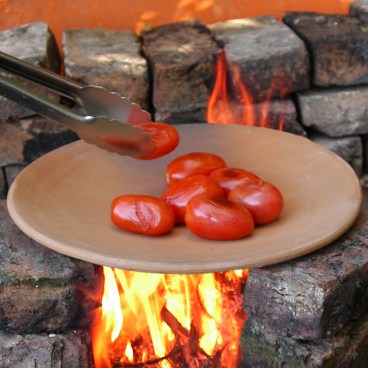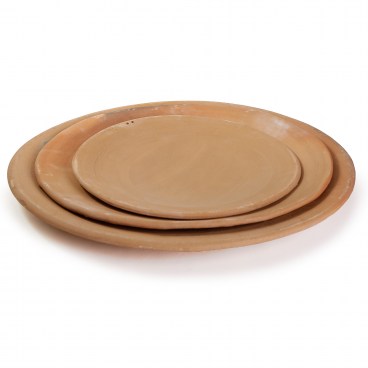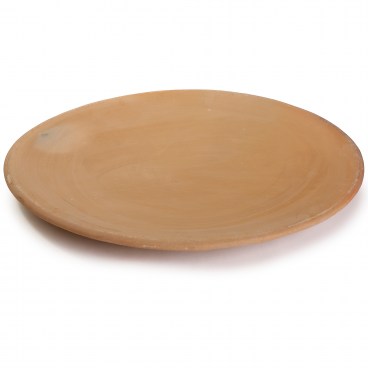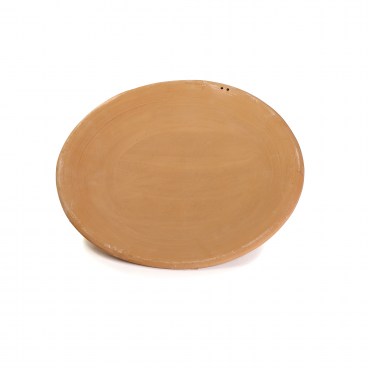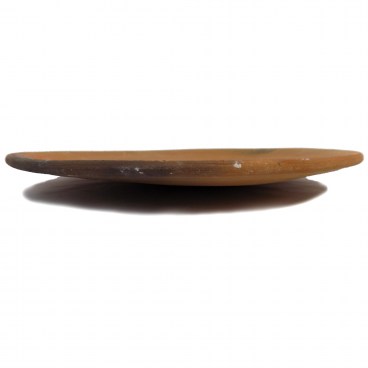Mexican Clay Comal
About the piece
Care and Use
Curing
How they are Made
As its Aztec name (comalli) suggests, the Comal has its roots in Mexico since Ancient times, however they are also widely used throughout Central and South America. It is an essential tool used in many applications such as in preparing tortillas, toasting spices, and roasting vegetables. They are also used to sear meat, and prepare recipes such as quesadillas. In many Hispanic households, the Comal are handed down from generation to generation as family heirlooms since they become seasoned over the years.
Most Comals sold in the United States are made of Cast Iron, but these are authentic clay Comals made with natural untreated clay (comal de barro) and coveted for their slow heat distribution. With use, the Comal becomes seasoned and like cast iron skillets or woks, they give food that little extra hint of flavor.
A clay comal is very fragile and can break in not taken care of. Be careful when moving it, or washing it, and make sure not to hit the sides against any objects.
A clay comal can be used on a stove top, both gas or electric, direct flames or if you wish, an oven or microwave. If you use an electric range, it is recommended to use a heat diffuser as it has the benefit of distributing the heat slowly to prevent foods from burning. A clay comal can be used on an induction cooktops however, it needs to be used with a induction cookware interface disk.
As with any clay or glass cookware, a clay comal must not be submitted to drastic changes in temperature. The comal should be allowed to slowly adjust to heat, letting it slowly heat up until they are hot. Likewise, always allow the comal to cool to room temperature before washing or storing it, and never set a hot comal on a cold surface such as granite or tile.
To clean a clay comal, you can wash it by hand with warm soapy water. Never put a clay comal in a dishwasher, not only can it absorb some of the soap taste, but since it is so fragile, it can break. If heavily soiled, you can soak the comal in warm soapy water and allow it to soak briefly, then scrubbing lightly with a sponge or soft cloth. Never use metal or abrasive cleaners, and always try to avoid strongly scented soaps which can flavor the clay.
Never use metal utensils, as it can scratch and damage the inside of the pieces, using wooden utensils instead. It is common for some staining or discoloration on the interior of the pieces to occur with use over time.
Appearance
As with most products which are handmade by artisans around the world, the comal may have slight imperfections in the form or finish of the materials, or on the glazed designs. Sometimes sizes of same model may also vary slightly, however, these imperfection do not compromise the aesthetics or functionality of the piece and are considered normal and expected.
Before using a Clay Comal, it must sealed and seasoned to prevent food from sticking, especially tortillas. To season it, put the comal over low heat and slowly bring it up to temperature. Prepare a watery mixture of dry lime (cal) and water and spread a thin layer of the mixture over the entire surface of the comal using a dry towel or brush. Heat it until the lime mixture dries and hardens. Once cool, rinse the comal, and repeat the process. The comal is now ready for use.
Dry lime is a chemical lime in the form of Calcium Hydroxide (aka Edible Lime, Hydrated Lime, CaH2O2). It is common in some food processing in Latin America, and has been for millennia.
Deep inside Mexico, in the semi-desert region in the Mexican state of Hidalgo, our cazuelas are made by hand by artisans whose craft has been handed down for several generations. Unlike their ancestors’ methods, today, the process has been changed for the better by glazing the cazuelas with lead-free glazes. On the right, you can see the video on the entire process.
The process begins by the unearthing of the clay from local quarries.The chunks of clay are then transported o the artisan’s 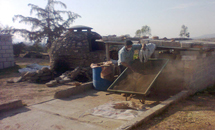 compounds and spread out to dry thoroughly. Once dry, the chunks are ground with the help of an electric grinder, a modern day addition, until they are ground into a fine powder. The powder is then sieved to insure a uniform size, as well as eliminating any possible rocks or pebbles.
compounds and spread out to dry thoroughly. Once dry, the chunks are ground with the help of an electric grinder, a modern day addition, until they are ground into a fine powder. The powder is then sieved to insure a uniform size, as well as eliminating any possible rocks or pebbles.
The finely ground clay is combined with a little water and mixed by hand. 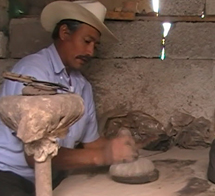 The artisan continues adding water and kneading the mixture, much like a bread maker kneads bread. For the normally large batches this is done on the floor of their workshop.
The artisan continues adding water and kneading the mixture, much like a bread maker kneads bread. For the normally large batches this is done on the floor of their workshop.
To make the clay cazuelas, the artisan takes a piece of clay sufficiently large for the intended piece, and pounds it to the thickness required by the piece with a tool much like a meat pounder made from lava rock, the same material as a Molcajete.
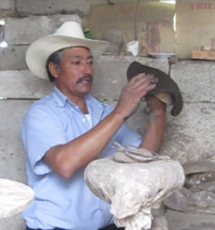 The flattened clay is then molded over molds of the desired shape and size to ensure accurate reproduction of sizes. The piece is then rubbed by hand with water, and further rubbed with a wet lava stone to seal the pores of the clay.
The flattened clay is then molded over molds of the desired shape and size to ensure accurate reproduction of sizes. The piece is then rubbed by hand with water, and further rubbed with a wet lava stone to seal the pores of the clay.
The clay is then turned over and out of the mold, and let to air dry. Once the clay begins to harden, the interior is smoothed with a wet sponge and rubbed with a small wet lava stone to seal the pores on the interior of the piece. The rubbing inside and out of the pieces is a time consuming and laborious task, but results in excellent quality cazuelas, unlike some others rustically made which are available.
The next step of the process is the putting of the handles. To do so, the artisan begins by rolling a piece of 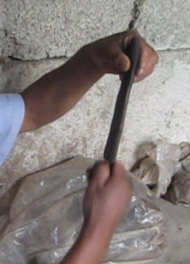 clay forming a rod shaped piece. The rod is then slowly flattened on the work bench using the palms. Dipping the rod in water to make it slippery, the artisan then holds the flattened rod with one hand he uses his other hand to run his thumb downward along the flattened rod to shape the handle the desired contour and making ridges. He then snips off a length to trim the handle to the required length.
clay forming a rod shaped piece. The rod is then slowly flattened on the work bench using the palms. Dipping the rod in water to make it slippery, the artisan then holds the flattened rod with one hand he uses his other hand to run his thumb downward along the flattened rod to shape the handle the desired contour and making ridges. He then snips off a length to trim the handle to the required length.
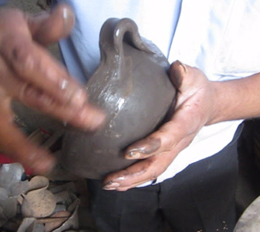 Once the handle is shaped, he attaches the handle to the piece smoothing the joint between the two pieces of clay making the joint invisible.
Once the handle is shaped, he attaches the handle to the piece smoothing the joint between the two pieces of clay making the joint invisible.
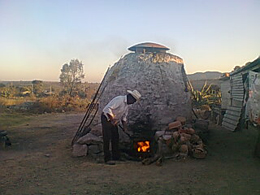 Once fully dry, the now dry and brittle pieces are sanded inside and out with porous lava rocks to ensure a smooth finish, and leaving them ready for the first firing. The first firing is done in a dome shaped wood burning over for over three hours. The pieces are stacked one on top of another in the upper chamber of the oven, while a hard wood fire is lit in the bottom chamber eventually reaching temperatures of over 1,000 degrees Fahrenheit.
Once fully dry, the now dry and brittle pieces are sanded inside and out with porous lava rocks to ensure a smooth finish, and leaving them ready for the first firing. The first firing is done in a dome shaped wood burning over for over three hours. The pieces are stacked one on top of another in the upper chamber of the oven, while a hard wood fire is lit in the bottom chamber eventually reaching temperatures of over 1,000 degrees Fahrenheit.
After the firing, the cooled pieces are then glazed. Our products are glazed with 100% lead free glazes which are arduously mixed slowly by hand so as to not introduce bubbles. To glaze the pieces, the artisan carefully dips the entire pieces in the glaze, letting the excess drip away. For larger pieces, the glaze is splashed on and let drip off. The glaze immediately begins to dry and become opaque. Once semi-dry, the bottom is scraped with a hard plastic tool to remove the glaze from the bottom which can cause the piece to stick to the kiln in the second firing. The bottom is then cleaned with a wet sponge.
Once the glaze is fully dry, the piece is then ready for the second firing. The second firing is done in a modern gas kiln to better control the temperature and conditions. If during the second firing, the temperature is too low, the glaze will not mature or become transparent, and if too high, it will become too melted and actually run off the piece.
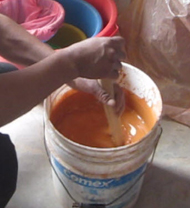
The pieces are then fired at between 950 to 1,000 degrees Fahrenheit and result in the beautiful Mexcian Clay Cazuelas we offer. After experiencing the entire process, which all told can take anywhere from 15 to 20 days from extracting the clay to the finished product, we have gained an appreciation for the artisans craft and a greater respect for their work.
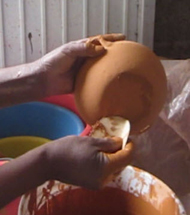




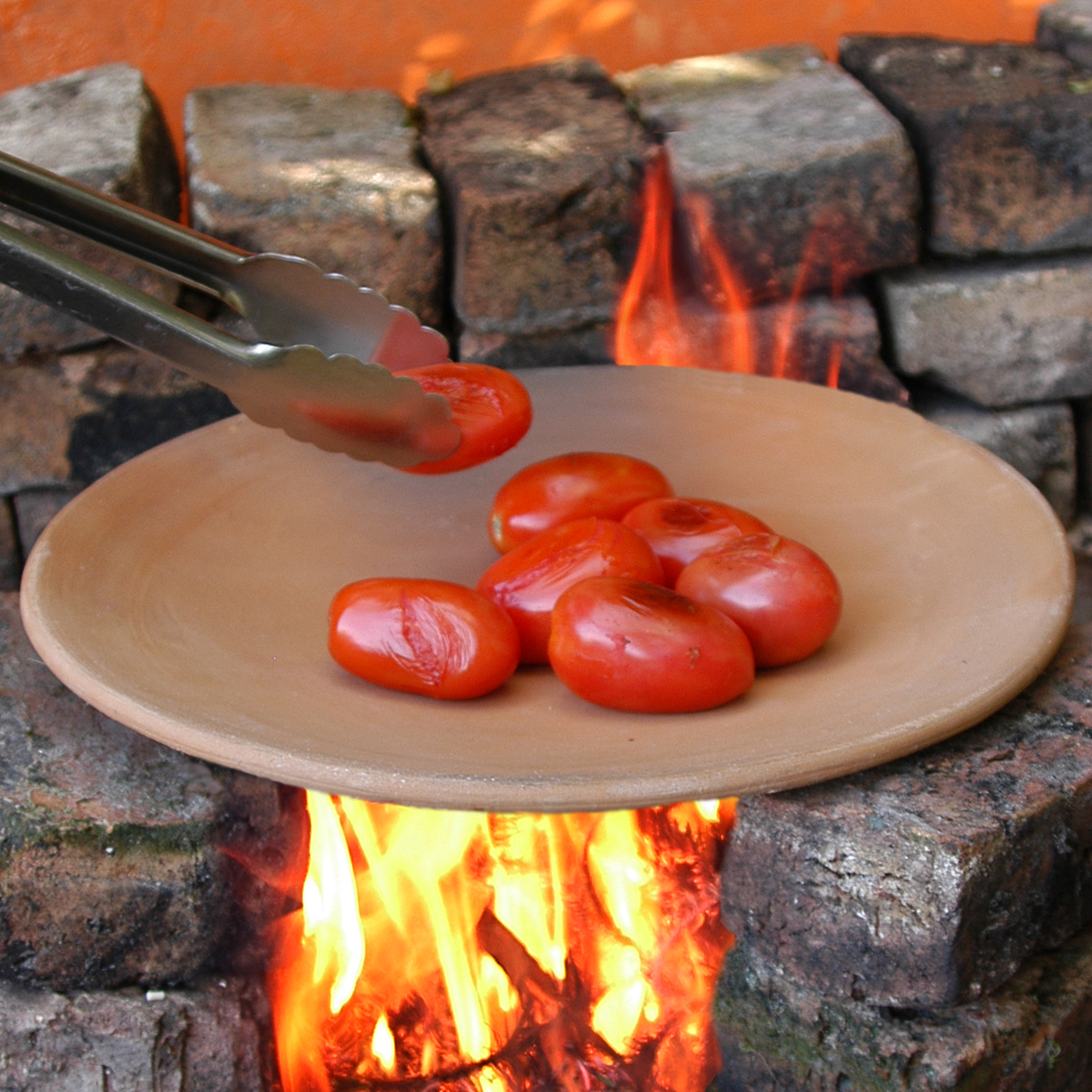
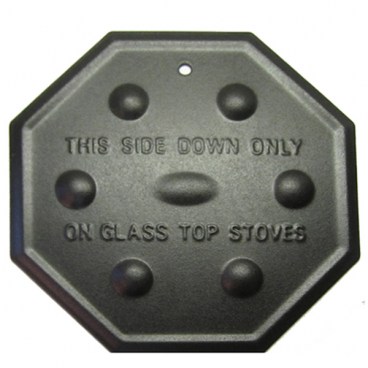
 Mexican Cal
Mexican Cal
